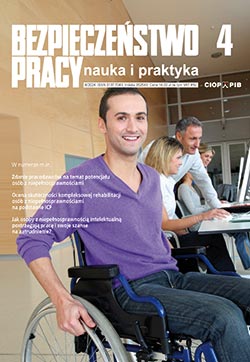Misją Instytutu jest dzialalność naukowo-badawcza prowadząca do nowych rozwiązań technicznych i organizacyjnych użytecznych w kształtowaniu warunków pracy zgodnych z zasadami bezpieczeństwa pracy i ergonomii oraz ustalanie podstaw naukowych do właściwego ukierunkowywania polityki społeczno-ekonomicznej państwa w tym zakresie.
-

Abstracts 2024 -

Abstracts 2023 -

Abstracts 2022 -

Abstracts 2021 -

Abstracts 2020 -

Abstracts 2019 -

Abstracts 2018 -

Abstracts 2017 -

Abstracts 2016 -

Abstracts 2015 -

Abstracts 2014 -

Abstracts 2013 -

Abstracts 2012 -

Abstracts 2011 -

Abstracts 2010 -

Abstracts 2009 -

Abstracts 2008 -

Abstracts 2007 -

Abstracts 2006 -

Abstracts 2005 -

Abstracts 2004 -

Abstracts 2003 -

CODE OF ETHICS & PEER REVIEW PROCEDURE -

GUIDELINES FOR AUTHORS
CODE OF ETHICS
&
PEER REVIEW PROCESS
Editors of the monthly are responsible for everything published in their journals.
We strive to:
- meet the needs of readers and authors;
- constantly improve the journal;
- ensure the quality of the material they publish;
- champion freedom of expression;
- maintain the integrity of the academic record;
- preclude business needs from compromising intellectual standards;
- always be willing to publish corrections, clarifications, retractions and apologies when needed.
Our Readers are informed about who has funded research and on the role of the funders in the research.
Editors of the monthly take all reasonable steps to ensure the quality of the material they publish, recognizing that our journal and sections within have different aims and standards. Our decisions to accept or reject a paper for publication are based only on the paper’s importance, originality, and clarity, and the study’s relevance to the remit of the journal.
- Studies that challenge previous work published in the journal are given sympathetic hearing. Studies reporting negative results aren’t excluded. We encourage academic integrity and, therefore, we ensure that research material we publish conforms to internationally accepted ethical guidelines.
- We do not publish artwork or features of persons without their explicit consent, even if the report is important to public health
- In case of allegations of misconduct we pursue alleged cases by first seeking a response from those accused.
- Whenever it is recognized that a significant inaccuracy, misleading statement or distorted report has been published, we correct it promptly and with due prominence. If, after an appropriate investigation, an item proves to be fraudulent, it gets retracted. The retraction is clearly identifiable to readers and indexing systems.
- Misleading advertisements is always refused, and we are willing to publish criticisms, according to the same criteria used for material in the rest of the journal.
PEER REVIEW PROCEDURE
1) Paper submission. All papers received by the editorial office of the monthly are either a result of the publication agenda of the Central Institute for Labour Protection or a result of external authors’ activity.
2) Early assessment. All papers submitted to the editorial office of the monthly are assessed at an angle of their compatibility with the monthly’s guidelines for authors, published at www.ciop.pl.
Should the basic guidelines be met the editing process commences. If the editorial office has any doubts, one of the scientific editors is brought in for counsel.
3) The first proofreading. The first proofreading is done by the members of the editorial office and its results are sent to the Author(s) of the paper.
4) Scientific proofreading. At this point a chosen scientific editor provides an opinion on the general scientific merit of the article in question. It’s being done in writing and the scientific editor grades the paper in the end on a scale of five, where no. 1 means “no remarks, go for publication”, no. 2 means “minor revision”, no. 3 means “major revision”, no. 4 means “Conditional rejection: the article needs to be completely rewritten and resubmitted for another review” and no. 5 means “Unconditional rejection”. Authors are provided with the opinion. Should the need arise for the statistical analysis, a statistical editor is being called upon for an opinion.
5) Peer review. The article in question is sent to two reviews who are considered: experts in the field, and come from different scientific communities in respect to both the author(s) and each other. Reviews are performed in the double blind mode, meaning both author(s) and reviewers’ identities are held in discretion by the editorial office. Reviews are performed in writing and each reviewer grades the paper in the end on a scale of five, where no. 1 means “no remarks, go for publication”, no. 2 means “minor revision”, no. 3 means “major revision”, no. 4 means “Conditional rejection: the article needs to be completely rewritten and reviewed again” and no. 5 means “Unconditional rejection”. Authors are provided with the reviews in writing.
6) Editorial board meeting. Each month an editorial board meeting is hosted during which articles that were granted “publish” status by scientific editors and peer reviewers are being assigned to specific issues on the monthly.

2024 - 2003
| Select year | Select issue |



